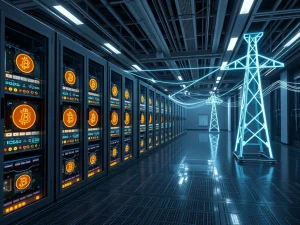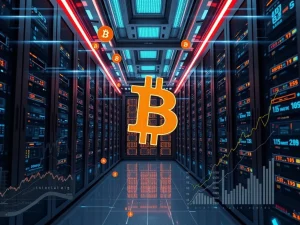Bitcoin Mining: Powerful Investments Fuel US Growth and AI Convergence

Institutional money is flooding into the world of Bitcoin mining, marking a significant shift. Big financial players are now investing directly in mining operations, not just buying Bitcoin itself. This surge is largely thanks to a supportive environment in the US and the potential for mining companies to also capitalize on the growing demand for AI computing power.
Why US Bitcoin Mining is Attracting Big Money
The United States has become a hotspot for US Bitcoin mining operations and the institutional capital backing them. Several factors contribute to this appeal:
- Favorable Regulatory Environment: Compared to many other regions, the US offers more clarity and a generally welcoming stance towards crypto-related businesses, including mining. This reduces uncertainty for large-scale investors.
- Established Infrastructure: The US has robust energy grids and infrastructure suitable for setting up and scaling large mining facilities.
- Access to Capital Markets: US markets provide easier access to funding through IPOs, debt financing, and private placements, essential for scaling large operations.
Is Bitcoin Mining Still Profitable? Understanding Mining Profitability
Understanding mining profitability is key for investors. While dynamic, recent data suggests profitability exists, though estimates vary significantly:
- CoinShares reported the average cost for US-listed miners was around $55,950 per BTC in Q3 2024.
- MacroMicro data from a specific day (Feb 20) showed an average cost above $92,000.
- Glassnode’s Difficulty Regression Model on the same day estimated the cost closer to $34,400.
These figures highlight that profitability depends heavily on factors like electricity costs (which vary wildly globally, from around $1,300 in Iran to over $321,000 in Ireland according to some estimates), hardware efficiency, and operational expenses. Despite pressures, many large US institutional miners remain profitable.
Beyond Bitcoin: AI Diversification Adds Appeal
A major driver of institutional investment interest is the strategic shift towards AI diversification. Bitcoin mining requires significant computational power and infrastructure (like power supply and cooling) that is also valuable for high-performance computing tasks needed for AI model training and inference. Mining companies can now lease out their hardware for AI processing, creating a new, potentially lucrative revenue stream that complements Bitcoin block rewards and transaction fees. This dual-use model makes the business more resilient and attractive to sophisticated investors looking for diversified tech plays.
Transaction Fees Bolster Miner Economics
In addition to the block subsidy (the newly minted Bitcoin miners receive), transaction fees paid by network users provide another income source. Over a recent month, daily transaction fees on the Bitcoin network averaged around $595,000, sometimes exceeding $1 million. This consistent revenue stream adds stability and boosts the overall economic model for miners, making them more appealing to institutional capital.
The Surge in Institutional Investment
The confluence of favorable conditions has led to a noticeable increase in institutional investment in the sector. US-based mining pools now represent a significant portion (over 40% in 2024) of the global Bitcoin network’s processing power (hashrate), indicating substantial operational scale within the country.
Surveys show strong intent from institutions to increase crypto exposure, with many considering investments in digital asset companies, including miners. This trend is visible in major investments and public offerings involving companies like Riot Platforms, CoreWeave, and Bgin Blockchain. CoreWeave, leveraging its infrastructure for both mining and AI, is reportedly aiming for a significant IPO valuation, while Bgin Blockchain also recently filed for a US IPO. This influx of capital is expected to drive expansion, potentially leading to consolidation as larger, well-funded players acquire smaller, struggling operations.
Political Tailwinds and Economic Impact
Recent political developments in the US have further boosted optimism. A more crypto-friendly stance from the Trump administration, including discussions around a potential Strategic Bitcoin Reserve, signals growing political acceptance and support for the industry. This is significant, as the US Bitcoin mining sector already contributes substantially to the national economy, generating billions in GDP and creating thousands of jobs, particularly revitalizing infrastructure and providing tax revenue in rural areas.
Conclusion: A New Era for Bitcoin Mining
The Bitcoin mining industry is evolving rapidly, transforming from a niche pursuit into a sophisticated infrastructure sector attracting serious institutional investment. Driven by a favorable US environment, improving mining profitability, strategic AI diversification, and increasing political support, the future looks bright. As large players double down on this convergence of digital assets and high-performance computing, the landscape is being reshaped. The US is well-positioned to lead this new phase, potentially becoming a global hub for this hybrid data processing industry. The modern digital gold rush is underway, and institutional capital is leading the charge.









